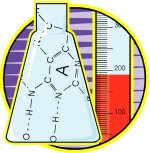
Worksheets and No Prep Teaching Resources
Reading Comprehension Worksheets
 Worksheets and No Prep Teaching Resources Reading Comprehension Worksheets |
|
| edHelper's suggested reading level: | grades 9 to 10 | |
| Flesch-Kincaid grade level: | 8.69 |
| Print Bond, Chemical Bond (font options, pick words for additional puzzles, and more) |
| Quickly print reading comprehension |
| Print a proofreading activity |
|
Bond, Chemical Bond
By Trista L. Pollard |

|
 1 Stumbling through the football field at school, you come across a pure element.... Nope! That would never happen because elements in pure form are very rare in the Earth's crust. If you were to locate an element, you would notice that it is part of a compound. A compound is two or more elements that are joined together through a chemical bond. This chemical bond happens between the atoms of the elements involved.
1 Stumbling through the football field at school, you come across a pure element.... Nope! That would never happen because elements in pure form are very rare in the Earth's crust. If you were to locate an element, you would notice that it is part of a compound. A compound is two or more elements that are joined together through a chemical bond. This chemical bond happens between the atoms of the elements involved. |
Create Weekly Reading Books
Prepare for an entire week at once! |
| Leave your feedback on Bond, Chemical Bond (use this link if you found an error in the story) |
 |
High School Reading Comprehensions and High School Reading Lessons
|